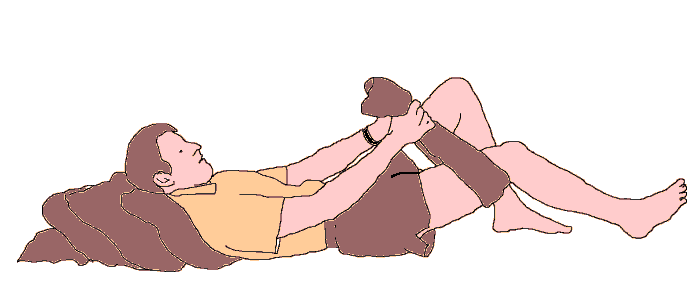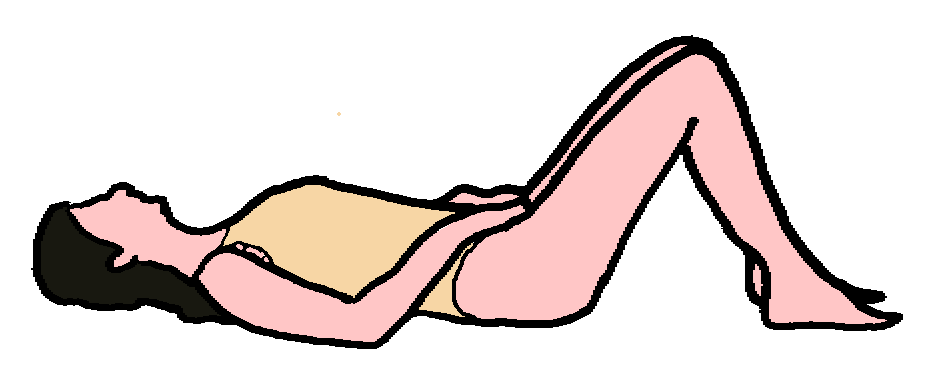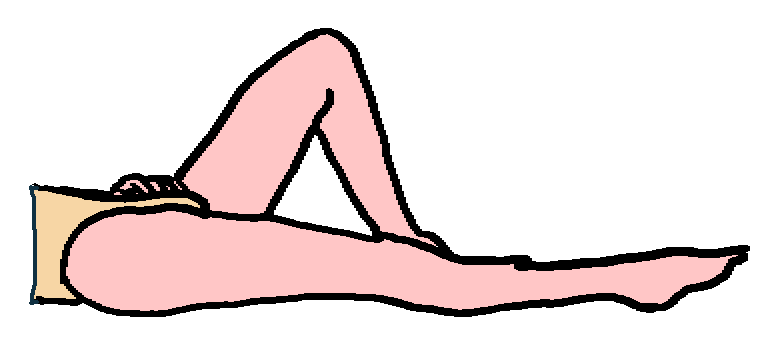|
|
|---|
This is the first in a progression of lower back rehabilitation exercises. Your eventual aim is to
extend (i.e. straighten) your hip joint(s) so that both legs are lying flat on
the floor with minimal back pain.
Assisted Heel Slide:- Start Position
- Lie on the floor in the Relaxation Position
- Place Pillows behind your head and shoulders, use a towel to make a sling for your right leg (diagram)
- Pelvic Neutral
- Anchor your scapulas.
- Chin gently tucked.
Assisted Heel Slide:- Action
- Zip and hollow and breathe in.
- (Breathing out): slide your right leg away from you while keeping your pelvis absolutely still.
Only take it as far as it will comfortably go.
- (Breathing in): maintain "Zip and Hollow", and at the same time, return the leg to the start position.
- Five times each leg!
Heel Slide without Assistance:- Action
If you can do the above exercise with a stable pelvis and without pain, try it without
the towel assist.
Assisted Heal Slides (Scroll right>>>>....)
|
Assisted Heel Slide Start Position:-

|
Assisted Heel Slide Action:-

|
Heel Slides Action:-

|
Heel Slide Action:

|
What this exercise does-
Puts you back in control of hip joint extension (straightening the leg). This is done by:-
- Improving the strength and/or control of your abdominal muscles so that
only your hip joint extends. (Your spine and pelvis do not move!)
- Gently stretching the Iliopsoas muscle - important if you are suffering
siatic nerve pain from iliopsoas compression of the spine.
- Giving complete control so that you work
within the limits of pain & abdominal muscle strength.
Assisted Heal Slides © Bruce Thomson, EasyVigour Project
|
Watch Points for Heel Slides
The aim of the Assisted Heal Slide is pain free hip extention while
keeping pelvis & spine absolutely still!
- Work slowly! Move within the limits of pain!
- Don't let your pelvis move! The pelvic clock face looks straight up and never deviates.
- If you cannot get your leg to lie flat on the floor without back pain or pelvis movement,
just take it as far as it will go. If even this is proving too difficult, seek
the help of a professional.
Comments
- This exercise is safe for almost any low back pain, and you should use it as your starting exercise.
- It is however especially useful for the kyphosis-lordosis posture type (see picture).
|

|
Reference
- Shirley A Sahrman: "Movement Impairment Syndromes" Publ. Mosby, 2002
ISBN 0-8016-7205-8
- Bruce Thomson Engage Gluteus maximus!
- Consequences of Office Chair Sitting(3):
Tight Hamstrings, Iliopsoas Trigger Points,Erector Spinae Muscle Fatigue.
- The Triggerpoint Therapy Workbook...
|




